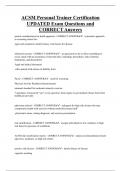ACSM Personal Trainer Certification
UPDATED Exam Questions and
CORRECT Answers
pretest considerations for healh appraisal - CORRECT ANSWER✔✔- systematic approach
in screening clients for:
signs and symptoms, family history, risk factors for disease
informed consent - CORRECT ANSWER✔✔- an agreement to do or allow something to
occur, made with an awareness of relevant facts, including: procedures, risks, benefits,
limitations, and discomforts
-legal and ethical document
-often paired with release of liability form
Par-Q - CORRECT ANSWER✔✔- used for screening
Physical Activity Readiness Questionnaire
minimal standard for moderate intensity exercise
7 questions; if answered "yes" to any question, then require to get medical release form from
healthcare provider
physician referral - CORRECT ANSWER✔✔- safeguard for high risk clients who may
compromise health with exercise without medically trained staff
-physician's name, stating diagnosis, and exercise perscription
risk stratification - CORRECT ANSWER✔✔- assigns individuals to low, medium, or high
risk based on presence of conditions
ACSM risk stratification matrix - CORRECT ANSWER✔✔- makes recommendations based
upon low, moderate, or high risk clients
positive risk factors - CORRECT ANSWER✔✔- family history of disease
cigarette smoking
,hypertension
hyercholesterolemia/dyslipidemia
impaired fasting glucose
obesity
sedentary lifestyle
family history of disease - CORRECT ANSWER✔✔- myocardial infarction, coronary
revascularization, or sudden death before age 55 in males and 65 females (1st degree
relatives)
cigarette smoking - CORRECT ANSWER✔✔- currently smoking or quit withing 6 months,
or exposed to 2nd hand smoke over 6 months
hypertension - CORRECT ANSWER✔✔- clients currently taking antihypertensive
medication and/or confirmed (2 separate occasions) 140/90 BP or higher
hypercholesterolemia/dyslipdemia - CORRECT ANSWER✔✔- clients currently taking lipid
lowering medication and/or those with total serum cholesterol >200 mg/dL, or high density
lipoprotein cholesterols of 0.35 mg/dL
impaired fasting glucose - CORRECT ANSWER✔✔- fasting blood glucose > or equal to
110 mg/dL (2 separate measurements)
obesity - CORRECT ANSWER✔✔- BMI > or equal mg/m^2 or waist girth exceeding
approximately 39.4 inches
sedentary lifestyle - CORRECT ANSWER✔✔- those not meeting recommended amount of
physical activity (at least 30 minutes of physical activity at a moderate intensity 40-60%, at
least 3 days a week for at least 3 months)
negative risk factors - CORRECT ANSWER✔✔- high serum HDL cholesterol: >60 mg/dL
,emerging risk factors - CORRECT ANSWER✔✔- inflammatory markers: reactive C protein
(CRP) and fibrinogen
low risk - CORRECT ANSWER✔✔- men <45, women <55, asymptomatic, with 1 or less
risk factors
A) current medical examination and exercise testing prior participation- not necessary for
moderate or vigorous exercise
B) physician supervision of exercise tests- not necessary for submax or maximal tests
moderate risk - CORRECT ANSWER✔✔- men >45, women >55, or those who meet the
threshold for 2 or more risk factors
A) current medical examination and exercise testing prior participation- not necessary for
moderate but recommended for vigorous exercise
B) physician supervision of exercise tests- not necessary for submax but recommended for
maximal tests
high risk - CORRECT ANSWER✔✔- 1 or more signs and symptoms listed or a known
cardiovascular, pulmonary, or metabolic disease
A) current medical examination and exercise testing prior participation- recommended for
moderate or vigorous exercise
B) physician supervision of exercise tests- recommended for submax or maximal tests
exercise testing steps - CORRECT ANSWER✔✔- M.R.I.P.L.
medical history
risk factor assessment
interpreting the data (cardio endurance, muscle strength/endurance, flexibility, body comp)
prescribing exercise program
lifestyle counseling
stress test - CORRECT ANSWER✔✔- usually only recommended by physician if the client
has symptoms of coronary artery disease, or significant risk factors for CAD
, do NOT do vigorous exercise with: - CORRECT ANSWER✔✔- clients with diagnosed or
present cardio diseases, congenital abnormalities, and/or hereditary abnormalities:
hypertrophic cardiomyopathy
coronary arter abnormalities
aortic stenossi
signs/symptoms of cardiovascular and pulmonary disease - CORRECT ANSWER✔✔- -pain,
discomfort, distress in areas that may be due to ischemia (chest, neck, jaw, arms, etc.)
-shortness of breath at rest or mild exertion
-dizziness or syncope
-edema, especially ankle
-tachycardia, or other arrhythmic occurrences (known heart murmur)
-orthopnea or paroxysmal dyspnea
-intermittent claudication
-unusual fatigue or shortness of breath with ADLs
ischemia - CORRECT ANSWER✔✔- an inadequate blood supply to an organ or part of the
body, especially the heart muscles.
-can result in heart attack, can by silent
intermediate condition of CAD
edema - CORRECT ANSWER✔✔- puffy swelling of tissue from the accumulation of fluid
-common in arms, hands, legs, ankles, and feet, face, abdomen
*symptoms:* swelling of tissue directly under skin, stretched or shiny skin, skin that pits after
being pressed, increased abdominal size
-remove salt from clients diet may help with swelling
-can be sign of underlying disease (heart failure, kidney disease, cirrhosis of liver etc.)
orthopnea - CORRECT ANSWER✔✔- ability to breathe only in an upright position
-difficulty breathing in supine position
-usually indicative of left ventricular dysfunction




